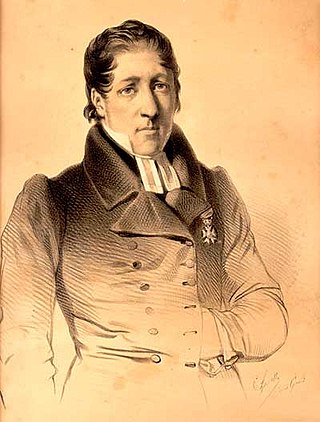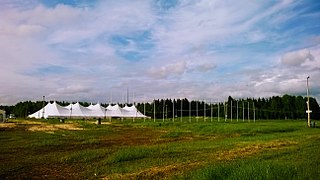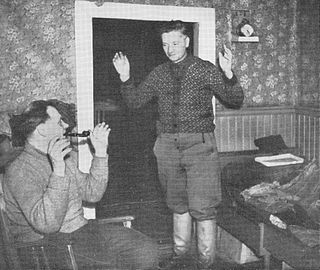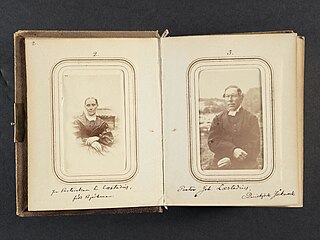Laestadianism, also known as Laestadian Lutheranism and Apostolic Lutheranism, is a pietistic Lutheran revival movement started in Sápmi in the middle of the 19th century. Named after Swedish Lutheran state church administrator and temperance movement leader Lars Levi Laestadius, it is the biggest pietistic revivalist movement in the Nordic countries. It has members mainly in Finland, Northern America, Norway, Russia and Sweden. There are also smaller congregations in Africa, South America and Central Europe. In addition Laestadian Lutherans have missionaries in 23 countries. The number of Laestadians worldwide is estimated to be between 144,000 and 219,000.
Pietism, also known as Pietistic Lutheranism, is a movement within Lutheranism that combines its emphasis on biblical doctrine with an emphasis on individual piety and living a holy Christian life.

The Laestadian Lutheran Church (LLC) is a religious Christian movement, its teachings based on the Bible and the Lutheran Confessions. From June 9, 1973, the organisation was named the Association of American Laestadian Congregations (AALC), before the association changed its name in 1994 in order better to convey its spiritual heritage. As of 2016, the Laestadian Lutheran Church has 33 member congregations in the United States and Canada, with highest concentrations of members in Minnesota, Washington, Arizona, Michigan in the United States and in Saskatchewan, Canada; the congregations are served by about 90 ministers, nearly all of them lay preachers.

Lars Levi Læstadius was a Swedish Sami pastor and administrator of the Swedish state Lutheran church in Lapland who founded the Laestadian pietist revival movement to help his largely Sami congregations, who were being ravaged by alcoholism. Laestadius was also a noted botanist and an author. Laestadius himself became a teetotaller in the 1840s, when he began successfully awakening his Sami parishioners to the misery and destruction alcohol was causing them.

Pajala is a locality and the seat of Pajala Municipality in Norrbotten County, Sweden, with 1,958 inhabitants in 2010. It is located in Swedish Lapland.
The Laestadian church arrived in North America with Nordic immigrants in the latter half of the 19th century, many of whom came to work in the copper mines of the Keweenaw Peninsula. Some of these new immigrants found themselves in conflict with older, established immigrants from the same countries, being generally poorer and less established, and hewing to the new, fundamentalist teachings of Lars Levi Laestadius, a Swedish-Sami preacher and botanist born in Arjeplog, Sweden. Laestadian congregations separate from the extant Scandinavian Lutheran churches were formed in Cokato, Minnesota, in 1872 and in Calumet, Michigan, in 1873.

The Apostolic Lutheran Church of America (ALCA) is a Laestadian Lutheran church denomination established by Finnish American and Norwegian immigrants in the 1800s. They came mainly from northern Finland and northern Norway where they had been members of the state churches. Most or all members had ties from their home countries to the Laestadian revival movement named after Swedish state church administrator and pastor Lars Levi Laestadius of Pajala, Sweden. Eventually, there were too many arguments between this denomination and the other American Laestadians, and some of the followers of Laestadius were excluded from the sacrament of holy communion. Under the lead of Salomon Korteniemi, the excluded members formed a congregation of their own in December 1872, under the name the Salomon Korteniemi Lutheran Society. In 1879 this name was changed to the Finnish Apostolic Lutheran Congregation. As other congregations of Finns in Massachusetts, Michigan, Minnesota, and Oregon were organized on the same basis, they came into fellowship with this body under the name the Finnish Apostolic Lutheran Church, or, as it is usually called, the Apostolic Lutheran Church.

Summer services is the annual meeting of the Finnish Lutheran movement known as Conservative Laestadians. In addition to the primary Finnish gathering, similar meetings are arranged in North America, Sweden and Russia.
The Central Association of the Finnish Associations of Peace is a Conservative Laestadian organization in Finland. It is part of Conservative Laestadianism and its sister organization in North America is Laestadian Lutheran Church. SRK has 179 Associations of Peace in Finland and eight in Russia. It has also sister organizations in Sweden and Estonia. It does mission work in 18 countries.
The Estonian Lutheran Association of Peace is a conservative laestadians organization in Estonia. It has one Association of Peace in Tartu. It does mission work in Tallinn, Tartu and Southeast Estonia. It has sister organizations in Finland, Sweden and North America.
An Association of Peace is an official grouping of conservative Laestadians. In Europe there are 214 Associations of Peace: 179 in Finland, eight in Russia, five in Sweden, one in Norway and one in Estonia. There are also three central organizations: SRK in Finland, SFC in Sweden and Estonian Lutheran Association of Pecae in Estonia. The Laestadian Lutheran Church does mission work worldwide in collaboration with Association of Peace organizations.
Firstborn Laestadians are a subgroup within the Laestadian Lutheran revival movement. The Firstborn are known for their traditionalism and their conservative pietistic ideals, and they seek to avoid "worldly pleasures". The name "Firstborn" derives from the Bible's Epistle to the Hebrews, Heb. 12:23, which mentions "the church of the firstborn".

The Korpela movement, or Siikavaara sect, was a religious sect started by Laestadian preacher Toivo Korpela in Sweden during the 1920s. It saw its decline later during the next decade as its practices involved heavy drinking and unconventional sexual activities toward the end of its existence, which subsequently led to the conviction of 60 of its followers.
Lutheranism is a major branch of Protestantism, identifying primarily with the theology of Martin Luther, the 16th-century German monk and reformer whose efforts to reform the theology and practices of the Catholic Church launched the Protestant Reformation.

The Old Apostolic Lutheran Church of America (OALC) is a Firstborn Laestadian church in North America. Firstborn Laestadians are a subgroup within Laestadianism. The Old Apostolic Lutheran Church originated in the 1890s. In the Nordic Firstborn Laestadian revival, the movement works within the official Church of Sweden, which is also called the "Lutheran Folk Church". The Church of Sweden has for a long time recognized the Laestadian movement and has allowed them to hold their own services in the state churches, both before and after the separation of church and state. Even in America it still has a relationship with the Church of Sweden.
Oskari Heikki Jussila was a Conservative Laestadian provost, vicar for multiple parishes, and the area provost of the Tornio area in 1938–1955. He also worked as editor for the religious newspapers Siionin lähetyslehti and Zions missionstidning in 1919–1945, as well as a member of parliament with the National Coalition Party in 1922–1929 and 1930–1933. Jussila's father was Heikki Jussila (1863-1955), a Conservative Laestadian lay preacher and Volksschule teacher.
Milla Clementsdotter (also known as, Milla Clemensdotter, Maria of Lappland was a Swedish Southern Sami woman who is remembered for guiding Lars Levi Laestadius in questions of Christian faith. She belonged to a revival movement marked by Pietistic and Moravian influences, a member of a group known as "Readers", a background shared by Laestadius' mother.

The Laestadius family is a Swedish family originally from Ångermanland, and mostly noted for its member Lars Levi Laestadius, the founder of the pietistic Lutheran revival movement, Laestadianism.

Läsare or the Reader movement was a Swedish Pietistic Christian revival movement of people who stressed the importance of reading, that is, reading the Bible and other Christian literature. It was influenced by both the Herrnhuters and the Methodists and has been described by scholar George M. Stephenson as a "second religious reformation in Sweden".
Pehr Brandell, also known as Per, Petrus, and Petter, was a Swedish Lutheran priest known for his role in the 19th-century revivalist movement in Norrland.
















